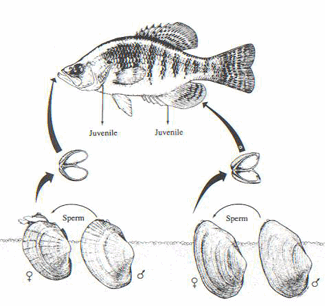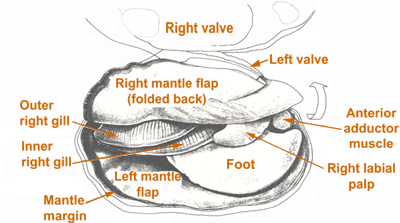Mussel
Life Cycle Activity
 Objective:
Students will be able to describe the life cycle of the mussel, explain
how it uses another animal in the cycle, and predict how that cycle
can be impacted by habitat change or degradation.
Objective:
Students will be able to describe the life cycle of the mussel, explain
how it uses another animal in the cycle, and predict how that cycle
can be impacted by habitat change or degradation.
Grades:
4-8
Time Required: One class period
(from
Cummings and Mayer 1992: 2.)
Motivation:
Sometimes the survival of a species depends on the presence or absence
of other species of animals in the same habitat. The freshwater mussel
is one such example. Its survival depends on the presence of one or
more species of fish on which the mussel larvae attach themselves for
a period of their life. This interdependence teaches us about the delicate
balances that exist in nature. Scientists can monitor the numbers of
these mussels and fish in a river to keep track of this balance. If
the water quality or other related characteristic of the habitat changes,
the mussel may not be able to complete its life cycle. By being aware
of these life cycles, students may become more knowledgeable stewards
of nature.
Online
Resources: Illinois State Museum's Web modules: https://www.museum.state.il.us/RiverWeb/harvesting/index.html
Department of Natural Resources Web site: https://dnr.state.il.us/lands/education/mussels/intro.htm
Materials:
Mussel cycle diagram
Mussel anatomy diagram
Photographs of musseling on the Illinois River from the Harvesting
the River Online section of the ISM web site. (see link above)
Discussion:
Teacher will orally describe mussel anatomy and mussel life cycle diagrams,
detailing the reproductive cycle and its reliance on one or more species
of fish.

Examination
of the gills of the mussel: Look at the gills of the mussel in the
diagram (or in a real mussel). This breathing organ is used by the mussel
as the means to expel the larvae. Expelling of larvae from the gills
of the mussel: The gills expel the larvae into the water, where they
float on the current, shells open, until they touch something, when
they close their shells. Sometimes they have attached themselves to
the gills or fins of their host fish, but most often they have attached
themselves to something else and die. Only a small percentage of larvae
survive.
Attachment
of the larvae to the fish: The larvae attach themselves to the gills
or fins of the fish, where they are covered up by tissue that grows
around them. They undergo metamorphosis into the juvenile state. After
two weeks to two months, the juveniles drop off the fish and settle
into the bed of a lake or river.
Questions:
What is the advantage of the larvae being attached to an organism
rather than floating around in the river?
The best theory for the elaborate life cycle of the freshwater mussel
is species dispersal. Without fish hosts, mussels would have great difficulty
dispersing their offspring upriver or from one river system to another.
Over time, the geographical ranges of mussel species would shrink to
nothing. Mussel larvae do receive protection and nutrition from their
hosts, but dispersal is more important. It is interesting to note that
zebra mussels, a non-native exotic species, which have free-floating
(Veliger) larvae that do not attach themselves to hosts, are quite successful
in nature (with the aid of humans) even though their larvae are exposed
to predators after being expelled from the parent.
What
difficulties are caused by this method of reproduction for the survival
of the mussel species? If a species depends upon another species,
there is danger when the other species is threatened.
What
happens if there are no fish? If there are no fish, the mussel cannot
reproduce at all.
Assessment:
Students should be able to point out the gills of the mussel on the
diagram or mussel, tell how the gills expel the larvae into the water,
tell how the larvae attach themselves to a host fish, how the larvae
grow on the fish, and how the juvenile mussels drop off the host. They
should also be able to explain the difficulties for survival with this
method of reproduction cycle.
Illinois
State Board of Education Goals Addressed:
Science: Late Elementary:
12.A.2a: Describe simple life cycles of plants and animals and the
similarities and differences in their offspring.
12.B.2a: Describe relationships among various organisms in their
environments (e.g., predator/prey, parasite/host, food chains and food
webs).
12.B.2b: Identify physical features of plants and animals that
help them live in different environments (e.g., specialized teeth for
eating certain foods, thorns for protection, insulation for cold temperature).
12.B.3b: Compare and assess features of organisms for their adaptive,
competitive and survival potential (e.g., appendages, reproductive rates,
camouflage, defensive structures).
13.B.2e: Identify and explain ways that technology changes ecosystems
(e.g., dams, highways, buildings, communication networks, power plants).
13.B.3e: Identify advantages and disadvantages of natural resource
conservation and management programs.

